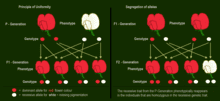Frankster
Never trust a doctor who's plants have died.
Supporter
- 5,188
- 313
- Characters are unitary. That is, they are discrete (purple vs. white, tall vs. dwarf).
- Genetic characteristics have alternate forms, each inherited from one of two parents. Today, we call these alleles.
- One allele is dominant over the other. The phenotype reflects the dominant allele.
- Gametes are created by random segregation. Heterozygotic individuals produce gametes with an equal frequency of the two alleles.
- Different traits have independent assortment. In modern terms, genes are unlinked.

Characteristics Mendel used in his experiments

P-Generation and F1-Generation: The dominant allele for purple-red flower hides the phenotypic effect of the recessive allele for white flowers. F2-Generation: The recessive trait from the P-Generation phenotypically reappears in the individuals that are homozygous with the recessive genetic trait.

- Form of the ripe seeds (round or roundish, surface shallow or wrinkled)
- Colour of the seed–coat (white, gray, or brown, with or without violet spotting)
- Colour of the seeds and cotyledons (yellow or green)
- Flower colour (white or yellow)
- Form of the ripe pods (simply inflated, not contracted, or constricted between the seeds and wrinkled)
- Colour of the unripe pods (yellow or green)
- Position of the flowers (axial or terminal)
- Length of the stem
| Law of dominance and uniformity | Some alleles are dominant while others are recessive; an organism with at least one dominant allele will display the effect of the dominant allele.[18] |
| Law of segregation | During gamete formation, the alleles for each gene segregate from each other so that each gamete carries only one allele for each gene. |
| Law of independent assortment | Genes of different traits can segregate independently during the formation of gametes. |
Zygosity (the noun, zygote, is from the Greek zygotos "yoked," from zygon "yoke") (/zaɪˈɡɒsɪti/) is the degree to which both copies of a chromosome or gene have the same genetic sequence. In other words, it is the degree of similarity of the alleles in an organism.
A cell is said to be homozygous for a particular gene when identical alleles of the gene are present on both homologous chromosomes. The cell or organism in question is called a homozygote. True breeding organisms are always homozygous for the traits that are to be held constant.
An allele (UK: /ˈæliːl/, /əˈliːl/; US: /əˈliːl/; modern formation from Greek ἄλλος állos, "other")[1][2][3] is a variant form of a given gene,[4] meaning it is one of two or more versions of a known mutation at the same place on a chromosome. It can also refer to different sequence variations for a several-hundred base-pair or more region of the genome that codes for a protein. Alleles can come in different extremes of size. At the lowest possible end one can be the single base choice of a single nucleotide polymorphism (SNP).[5] At the higher end, it can be the sequence variations for the regions of the genome that code for the same protein which can be up to several thousand base-pairs long.
Sometimes, different alleles can result in different observable phenotypic traits, such as different pigmentation.
Multiple adeles
A population or species of organisms typically includes multiple alleles at each locus among various individuals. Allelic variation at a locus is measurable as the number of alleles (polymorphism) present, or the proportion of heterozygotes in the population. A null allele is a gene variant that lacks the gene's normal function because it either is not expressed, or the expressed protein is inactive.
For example, at the gene locus for the ABO blood type carbohydrate antigens in humans, classical genetics recognizes three alleles.
The Law of Segregation of genes applies when two individuals, both heterozygous for a certain trait are crossed, for example hybrids of the F1-generation. The offspring in the F2-generation differ in genotype and phenotype, so that the characteristics of the grandparents (P-generation) regularly occur again. In a dominant-recessive inheritance an average of 25% are homozygous with the dominant trait, 50% are heterozygous showing the dominant trait in the phenotype (genetic carriers), 25% are homozygous with the recessive trait and therefore express the recessive trait in the phenotype. The genotypic ratio is 1 : 2 : 1, the phenotypic ratio is 3 : 1.
The frequency of alleles in a diploid population can be used to predict the frequencies of the corresponding genotypes (see Hardy–Weinberg principle). For a simple model, with two alleles;




